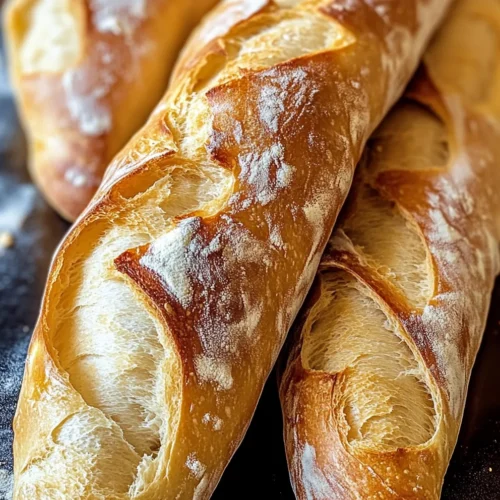There’s something deeply satisfying about pulling a homemade baguette out of your oven—the crackle of the crust as it cools, the warm aroma of yeast and flour filling your kitchen, and that first bite into the golden, blistered exterior revealing a soft, chewy center. Making bread at home used to intimidate me. But the first time I nailed a baguette—flour on my cheeks and a fresh loaf in my hand—I felt like I had cracked some ancient code. This recipe is my go-to, and it will be yours too.
It’s not just about baking bread; it’s about creating something with your hands that’s deeply nourishing, deeply personal. The best part? It only takes a handful of ingredients, a bit of patience, and a touch of love. Keep reading, because this baguette recipe might just become your favorite new ritual.
Why You’ll Love This Homemade Baguette Recipe
If you’ve ever been frustrated with store-bought baguettes that turn stale by the evening or DIY versions that come out dense and disappointing, this recipe will change the game for you.
I still remember bringing my homemade baguette to a weekend brunch. I placed it on the table with a few cheeses, some fig jam, and salted butter. People paused mid-conversation to ask, “Wait—you made this?” And when they bit into it? Eyes widened. My brother even asked if I had secretly bought it from a French bakery.
This recipe solves three major challenges:
- Achieving a crackling crust without professional ovens
- Getting an open, airy crumb without complicated folding techniques
- Mastering that perfect baguette flavor with minimal ingredients
It’s endlessly customizable too. You can mix in herbs, olives, or even roasted garlic. Make mini baguettes for sandwiches or larger ones for slicing. And it’s surprisingly forgiving—perfect for beginner bakers and seasoned pros alike.
Let’s break down what you’ll need.

Ingredients for the Perfect Homemade Baguette
The ingredient list is short, but don’t let that fool you. Each component is essential in creating that iconic baguette texture and flavor.
🌾 Bread Flour
- Why it matters: High protein content helps create strong gluten, which gives the baguette its chewy texture and beautiful rise.
- Substitution tip: All-purpose flour will work in a pinch but may result in a softer crust.
- Recommendation: Use unbleached, high-quality bread flour for best results.
💧 Water
- Why it matters: Hydration affects crumb structure. We’re aiming for around 75% hydration for that open crumb.
- Tip: Use lukewarm water to help activate the yeast.
🧂 Salt
- Why it matters: Enhances flavor and controls yeast activity.
- Type: Fine sea salt or kosher salt. Avoid iodized salt as it may impart bitterness.
🍞 Instant Yeast
- Why it matters: Gives the dough its rise and imparts that classic fermented flavor.
- Substitution: Active dry yeast works too—just dissolve it in water first.
- Pro Tip: For deeper flavor, reduce the yeast and use a longer fermentation (cold-proof overnight).
🌾 Optional: Whole Wheat Flour or Rye (for flavor variation)
- Add up to 10% of the total flour weight for depth and rustic flavor.
How to Make Homemade Baguette (Step-by-Step)
1. Mix the Dough
- In a large bowl, combine flour, salt, and yeast.
- Slowly add water and mix with your hand or a wooden spoon until shaggy.
- Cover with a damp towel and let rest 30 minutes (autolyse).
🌾 Tip: The dough will feel sticky. That’s normal—hydration is key for that open crumb.
2. Stretch and Fold
- Every 30 minutes for the next 2 hours, perform a stretch-and-fold:
- Wet your hands, grab one edge of the dough, stretch it up, and fold it over.
- Rotate the bowl and repeat 3 more times.
👀 Visual cue: Dough should become smoother and more elastic with each fold.
3. Bulk Fermentation
- Let the dough rise for 2–3 hours at room temperature until doubled.
- Or, refrigerate overnight for better flavor and easier shaping.
4. Shape the Baguettes
- Gently divide the dough into 2–3 pieces.
- Shape each into a rectangle, fold the long edges toward the center, then roll into a log.
- Let rest seam-side down on a floured surface for 10 minutes.
- Final shape: Gently roll each log into a 14-inch rope.
👃 Smell: The dough should have a slightly tangy, yeasty aroma.
5. Proof
- Place baguettes seam-side down on a floured couche or parchment.
- Cover and proof for 30–45 minutes until puffy but not over-risen.
6. Score and Bake
- Preheat oven to 475°F (245°C) with a baking stone or inverted baking sheet inside.
- Place a metal tray on the bottom rack (for steam).
- Transfer baguettes to the hot stone, score with a lame or sharp knife, and pour a cup of hot water into the tray below.
🔥 Bake for 20–25 minutes until golden brown and crusty.
👂 Listen: The crust should crackle as it cools—that’s the hallmark of a great baguette.
Creative Variations to Try
1. Herb & Garlic Baguette
- Add minced roasted garlic and chopped rosemary to the dough.
- Finish with a sprinkle of sea salt before baking.
2. Olive & Thyme Baguette
- Fold in chopped kalamata olives and fresh thyme leaves before shaping.
3. Whole Wheat Honey Baguette
- Swap 25% of the flour for whole wheat and add a tablespoon of honey for a nutty, slightly sweet loaf.
4. Cheese-Stuffed Baguette
- Roll shredded gruyère or mozzarella into the center before final shaping.
5. Seeded Crust Baguette
- Roll the shaped dough in sesame, poppy, or flax seeds before baking.
6. Cinnamon Raisin Baguette
- For a sweet twist, mix in raisins and a dash of cinnamon—amazing with cream cheese.

🥖 Homemade Baguette Recipe
Ingredients
Main Dough:
- 3 ½ cups 450g bread flour
- 1 ½ tsp fine sea salt
- 1 tsp instant yeast
- 1 ½ cups 360ml lukewarm water
Optional Add-ins:
- Up to ½ cup whole wheat or rye flour subbed in
- Chopped herbs olives, roasted garlic, etc. (see Variations below)
Instructions
Mix the Dough
- Combine flour, salt, and yeast in a bowl.
- Add water gradually, mixing until a shaggy dough forms.
- Cover with a damp towel and let rest for 30 minutes (autolyse stage).
- Stretch & Fold (2 hours)
- Every 30 minutes, perform a stretch-and-fold (4 times total):
- Grab, stretch, and fold the dough over itself, rotating the bowl each time.
- Dough becomes smoother and more elastic.
Bulk Fermentation
- Let the dough rise at room temp for 2–3 hours until doubled.
- Optional: Refrigerate overnight for extra flavor and easier shaping.
- Shape the Baguettes
- Divide dough into 2–3 portions.
- Gently shape into logs, rest 10 minutes.
- Roll into baguette shape (14” ropes), seam-side down.
Final Proof
- Place on floured cloth or parchment.
- Cover and let proof for 30–45 minutes until puffy.
Score & Bake
- Preheat oven to 475°F with baking stone and steam tray inside.
- Score baguettes with a lame or sharp blade.
- Slide onto hot stone, pour water into tray for steam.
- Bake for 20–25 minutes until golden and crusty.
Notes
- Don’t skip the steam! It’s key to that crispy crust.
- Use bread flour for chewiness and structure.
- Overnight proofing boosts flavor and makes shaping easier.
- Let cool fully before slicing—hard, I know!
Nutrition
Frequently Asked Questions (FAQ)
Q1: How should I store homemade baguette?
A: Wrap in a clean kitchen towel and store at room temperature for up to 2 days. Avoid plastic—it softens the crust. For longer storage, slice and freeze.
Q2: Can I make the dough ahead of time?
A: Yes! The dough can cold-proof in the fridge for up to 48 hours. This actually improves the flavor.
Q3: How do I reheat a baguette?
A: Sprinkle lightly with water and warm in a 350°F oven for 5–8 minutes. It will re-crisp beautifully.
Q4: Is this recipe vegan?
A: Yes! The base recipe uses only flour, water, salt, and yeast. Just ensure your add-ins (like cheese) match your dietary needs.
Q5: Why is my baguette dense or flat?
A: Common reasons include under-proofing, over-proofing, or over-handling during shaping. Stick to gentle movements and don’t skip the folds.
Q6: Do I need a baking stone or couche?
A: Not essential, but highly recommended. A stone helps with heat distribution, and a couche keeps the baguettes from spreading. A floured towel and a hot baking sheet can substitute.
A Personal Note to End On
I’ll never forget baking this homemade baguette with my grandfather on a rainy Sunday afternoon. The house smelled like a Parisian boulangerie, and he told me it reminded him of walking home from school with a fresh loaf under his arm. That memory lives in every loaf I make.
This recipe is more than flour and water—it’s an invitation to slow down, use your hands, and connect with the soul of baking. Whether you’re kneading dough with your kids, impressing friends at dinner, or just feeding your curiosity, this baguette is yours to shape.
So go ahead—flour the counter, trust the process, and create something simple and beautiful.
